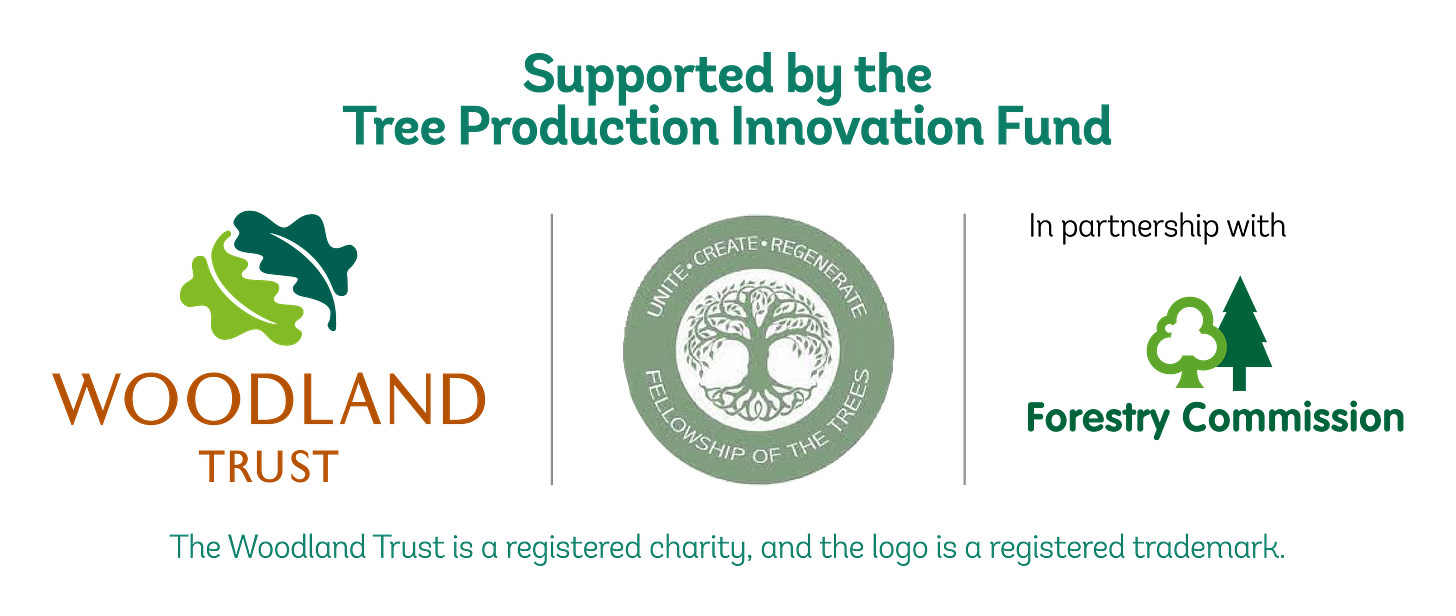Growing Diversity project - Introduction and background.
In this first post, I provide an introduction to the innovative Growing Diversity project and set the scene for the future posts.
Introduction and background to the Growing Diversity project
In this first post, I would just like to give a little introduction to the Growing Diversity project for those who have not heard of it and set the scene for the future posts. If you are new to the world of Community Tree Nurseries (CTNs), welcome! Please do reach out if you need any signposting or recommendations for resources and so on.
The Growing Diversity project is a partnership initiative between the Woodland Trust and Fellowship of the Trees, funded by the Forestry Commission’s Tree Production Innovation Fund. You can find out more about the Growing Diversity project here. The project started in the Autumn of 2023 and completes in March 2025. There has been a series of webinars on a range of pertinent topics such as: Biosecurity for CTNs, Introduction to Growing trees in CTNs and Pests and Diseases. You can view all webinars either on the Fellowship of the Trees Youtube channel here or via the Growing Diversity webpage here.
Fellowship of the Trees also facilitate the Community Tree Nursery Collaborative, a peer to peer learning network that covers the whole of the UK. There are regular webinars and Open Space sessions as part of the network. You can check out their events and find out more through the CTNC webpage here.
Growing Diversity has also supported a number of in person events with different CTNs around England, so one of the key purposes of this Substack is to share on the insights and key learning points gained from these events. So I aim to create a post on each event that has taken place and therefore this can be a central resource in the future a part of the legacy of the project.
What is the project all about?
One of the key aims of the project is to support and enable CTNs to strengthen their abilities to grow a diverse and healthy range of trees and contribute to increase the supply of such within the forestry sector in England. The aims and actions are set out below.
Key aims and actions
Boost domestic tree supply: aim to diversify and expand the tree supply in England, aligning with the government's ambition to triple tree planting by 2025.
Strengthen nurseries: equip nurseries of all sizes with the tools and knowledge they need to effectively meet the demands outlined in the England Trees Action Plan.
Embrace innovation: advocate for the adoption of state-of-the-art technologies and best practices to ensure high-quality and diverse tree stocks at value for money.
Build resilience: ensure tree species are resilient to challenges like climate change, pests, and diseases.
Focused seed sourcing: concentrate on sourcing bio-secure seeds and trees from specific native seed zones and address the current market shortcomings.
Empower community tree nurseries: bolster their capabilities in administration, skills, operations, marketing, and systems to meet forestry sector needs.
Address seed collection gaps: identify and act on regions where there's minimal seed collection, especially for hard-to-source native species.
Overcome barriers: develop strategies to address barriers in tree planting, offering training and resources on topics like seed collection, propagation, and biosecurity.
Foster innovation and collaboration: motivate community tree nurseries to adopt new methods, share expertise and gain access to specialised advice.
Promote native species: prioritise hard-to-source native broadleaf species for tree planting projects.
Engage the community: facilitate diverse tree planting initiatives, emphasising natural regeneration, traditional methods and hands-on community involvement.
In the next post I share on the Biosecurity event hosted at Moor Trees CTN in Dartington, back in February, which includes a short film that was produced as part of the event.
Thank you for reading and do subscribe!




